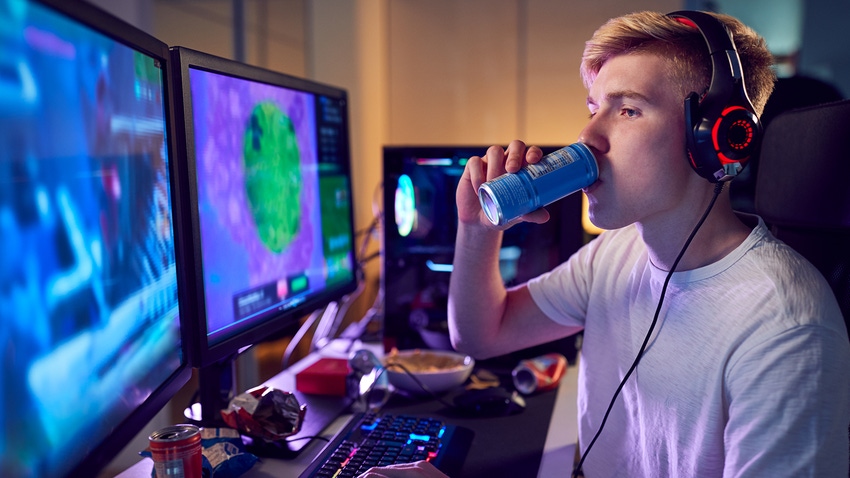How energy drinks are expanding to reach new audiences
The landscape of energy beverages is evolving, with a shift towards cleaner formulations, innovations in ingredients like nootropics for cognitive enhancement, and the expansion of the consumer base beyond traditional demographics to cater to diverse energy needs, while emphasizing trust, transparency and health-conscious preferences.

At a Glance
- Energy drinks are evolving beyond their traditional high-caffeine, edgy image to cater to a wider audience.
- The key trends driving this shift are consumer demand for “evolved” products.
- Cognitive optimization through ingredients like nootropics is a major growth area.
If you’ve ever wondered who makes up the over-amped core of the energy beverage audience, consider that 18- to 34-year-old males consume the most energy drinks, and almost one-third of 12- to 17-year-old teens drink them regularly, according to National Center for Complementary and Integrative Health.
No beverage category that’s set to hit a global market value of $108 billion by 2028 — as the energy beverages category is — can hope to reach such heights on the strength of adolescent fanboys alone (loyal consumers though they may be).
That’s why energy drinks are changing, along with their audience. Fresh formulations, mindful messaging and evolving benefits — among other traits — are expanding the sector’s appeal and promising it a long, lively future.
Appetite for energy
To be sure, the appetite for energy as we enter 2024 might as well be unlimited. Per FMCG Gurus’ Top Ten Trends for 2024 report, a mere 44% of consumers worldwide rate themselves as satisfied with their energy levels.
As far as Jordan Miller, VP of marketing at Nutrition21, is concerned, that “reflects a large market potential for brands that can deliver this benefit through an evolved beverage concept.”
“Evolved” is the name of the game, as a certain stigma tarnishes traditional energy beverages, at least for some consumers. “I think consumers in general are getting tired of overly aggressive, overly caffeinated products and brands that don’t resonate with their lifestyles,” Wayne Lutomski, founder of WNDY (We’re Not Dead Yet) Inc., said.
Sustained support
Even setting aside their characteristically bellicose messaging, however, old-school energy drinks are falling out of favor with many simply for failing to keep pace with how consumers are redefining the concept of energy itself.
For example, consumers have soured on the “short-term boost” that the category’s standard bearers have long provided, according to Miller. “There’s growing desire for energy products that support focus, performance, alertness and concentration,” he said. “That helps consumers tackle the many mental and physical stressors that life can throw our way.”
That’s why he bets that “sustained energy” that optimizes performance all day long “without the crash often experienced with caffeine and other stimulant-based energy products” will drive consumers and product development going forward.
Clean energy
“Keep in mind that there’s been a move away from stimulant-based energy ingredients,” Miller said.
In this space, that usually means caffeine. “Mindful consumers have even more specific deal-breakers when it comes to energy beverages,” Alicia Poole, marketing director at BioLift, said. “Concerns include chemical ingredients, excess sugar, safety issues — especially with younger consumers — and the historically aggressive image associated with some energy drinks.”
That bodes well for formulations that eschew excess caffeine and sugars, artificial ingredients and especially “sketchy” stimulants. “Products that can offer ‘clean’ or ‘natural’ energy will be poised for growth,” Miller said.
Diversified base
This attempt to clean up energy, so to speak, has “opened the door for greater innovation in the energy category,” Miller explained. That is clearing the way for an accompanying diversification of its consumer base.
Case in point, today’s energy beverage consumer might be a new mom “experiencing energy deficits related to their new responsibilities,” Miller said. Similarly, busy professionals fueling long work bouts, or students “aiming to stay focused for their next assignment,” will also be more likely to migrate to the market if they find products that speak to their sustained energy needs.
“In fact, when you think about it, there aren’t many pockets of consumers who can’t benefit from better energy — both physically and mentally,” Miller added.
Aging energetically
Lutomski agreed, putting the spotlight on what might not be among the first demographics to pop to mind when thinking of energy beverages, but probably should be: active seniors.
After all, energy deficits are a lifelong affliction. “The demands we face in this high-speed, high-technology world don’t diminish with age, and the No. 1 reason older adults aren’t living life to the fullest is lack of energy,” Lutomski said.
If edgy products with in-your-face names like Monster and Bang don’t appeal to the 55-plus set, however, it’s not just the marketing. Those consumers “tend to be more sensitive to caffeine extremes,” according to Lutomski.
Enter WNDY’s recently launched Hydro Shot energy drink, which pitches itself as “reshaping the narrative on wellbeing for adults 55 and above.” While the drink packs the caffeine content of one cup of coffee, “Its energy-producing capacity comes from its unique combination of molecular hydrogen-producing and nitric oxide-producing ingredients,” Lutomski said.
Nitric oxide encourages blood flow — particularly to the brain, where we need it for cognition. As we age, however, our bodies’ natural production falls, per Lutomski. Hydro Shot’s formulation helps the body turn that tide on its own, thus clearing “brain fog” and “offering a more natural, sustained energy source throughout the day without caffeine’s jitters — much more suited for the 55-plus consumer,” Lutomski said.
Get smart
“By boosting gases and amino acids already in the body, you can achieve many levels of sustained natural energy,” he explained. “If you can cut through the brain fog of all those video calls, projects and life in general, you can have a leg-up on meeting those demands.”
That why he thinks it’s through jumpstarting cognitive performance that next-generation energy beverages “can add a new layer of opportunity.”
Miller agreed, adding that “fueling the brain could arguably replace promoting physical energy in the space because this benefit has wider appeal to a larger number of consumers.” In fact, he pointed to results of a proprietary 2023 FMCG Gurus survey on cognitive health showing that 65% of U.S. consumers professed interest in food and drink products that offer sustained energy specifically for the brain.
New level
Ingredients generally associated with these benefits fall under the classification of nootropics — colloquially called “smart supplements” — and run to options like Ginkgo biloba (ginkgo), creatine, tyrosine and more.
Nutrition21’s hat to toss into the nootropic ring is nooLVL, “a safe, nonstimulant brain health ingredient clinically studied to enhance cognitive performance, fight mental fatigue and keep the brain sharp,” Miller said.
A 2022 open-label, repeated-intake study demonstrated significant improvements in measures of attention, concentration and ability to perform a task involving complex reasoning and spatial planning both acutely and after seven days of ingesting the ingredient. “Additionally, researchers observed significant improvements from baseline to day 7 in participants’ performance of a task centered on the ability to plan and think ahead,” Miller explained.
The ingredient also acts fast, he added, citing a 2019 double-blind, placebo-controlled trial that found it significantly increased mental acuity and focus within 15 minutes of intake. “The study also showed that nooLVL significantly improves accuracy, as well as attention and reaction time, even after 60 minutes of performing a mentally demanding task,” Miller said.
While some of the ingredients studies leaned on gamers and even experienced e-gamers as subjects, the intense focus, quick processing and strong cognition that the sport demands aren’t much different from what it takes to study, complete complex work projects or make decisions in challenging environments, Miller noted. In other words, this nootropic can benefit everyone.
Staying true
“Cognitive optimization is deemed a game-changer in the energy beverage category,” Poole said. “The trend towards enhancing cognitive performance reflects the changing needs of consumers in a highly distracted world.”
Even amidst the distractions, trust and transparency break through. “Innovation lies in delivering effective results without compromising safety or health concerns,” she explained. “The emphasis is on staying true to claims, ensuring clarity in messaging, and providing a safe and relevant product for today’s health-conscious consumers.”
About the Author(s)
You May Also Like






